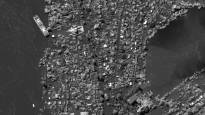The collapse of the Kahovka dam is not only a local problem in Ukraine, says University of Helsinki researcher Freek van der Vet. Huge amounts of pollutants and chemicals leak into nature, which end up in waterways and soon become a problem for other countries as well.
– This is a disaster that will affect Ukraine on many levels. It has already been compared to, for example, the Chernobyl nuclear power plant accident, University researcher Freek van der Vet says in Uutispodcast.
In Ukraine, the Kherson region is flooded as a result of the destruction of the Kahovka dam.
In addition to residential areas, fields and industrial areas, wastewater treatment plants and landfills have been left under the flood, from which wastewater has spread into the environment. There is now a shortage of clean water in the flood zone.
In addition, about 150 tons of oil from the hydropower plant inside the dam has spread into nature. There is also a risk that the strong flow of water may dislodge deposits containing radioactive residues from the bottom of the dam.
Van der Vet, a researcher at the University of Helsinki, believes that the pollution will end up in the Black Sea before long.
– If the pollution spreads to neighboring countries, the same harm will affect nature and people there as well, says van der Vet.
Environmental destruction can already be seen in the Hersoni region. Contaminated water has flooded e.g. to nature reserves, which endangers rare animal and plant species.
Agriculture suffers from polluted water and lack of water
In the flood zone, this summer’s crops have been lost, and the contaminated flood water has made the land unfit for cultivation.
The dammed artificial lake has been an important source of water in agriculture. Now, water cannot be supplied to the rest of Ukraine through the irrigation canals, so the entire country’s agriculture is suffering.
– Many will lose their livelihood in Ukraine because of this, but the effects of the flood on agriculture will probably be seen in other countries as well. People are unable to cultivate their own land, van der Vet says.
He thinks that the pollution spread by the flood water will also affect other countries’ fisheries, nature reserves and marine life in a significant way.
– It is important to understand that this problem does not remain only within the borders of Ukraine.
Risk of multiple Talvivaara
Van der Vet uses the Talvivaara mine accident in 2012 as an example when he describes the possible consequences of the Kahovka dam destruction and its scale.
– The Talvivaara nickel mine accident involved a leak from one of the hazardous waste facilities. There are 465 such facilities in Ukraine, so you can imagine how much hazardous waste will spread into the environment if even one of them is damaged in a flood.
Van der Vet says that it will take years to sort out the environmental damage. Still, we should act now, collect information and samples from contaminated areas. In the midst of war, it is difficult.
– It is far too late to take measures until after the war. The assessment of the environmental damage must start when it is still flooding.
Ukraine is investigating the destruction of the Kahovka dam as a war crime. In addition, it investigates the act as natural destruction. Ukraine is one of the few countries in the world where ecocide is a national crime.
